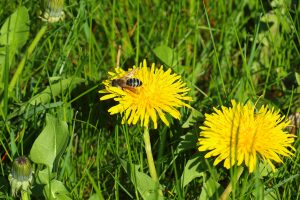Leaving dandelions on your lawns helps the pollinator populations
By Ryan Pankau University of Illinois Extension Services — May 4, 2023
There is growing interest in less intensive management of our landscape and simple things we can do, such as allowing weeds to bloom, which reduces inputs and benefits declining pollinator populations
Urban areas typically have a large proportion of turfgrass. From lawns and residential areas to golf courses, parks and rights-of-way, turf covers around 2 percent of the landmass in the US, or about 63,000 square miles.
Research has indicated that highly managed turfgrass offers little support to pollinators. However, most lawns have at least some flowering weeds, such as dandelions or clovers, that can provide pollinator benefits. To their demise, we have deemed these plants enemies of the turf and seek to control them, often with use of pesticides or whatever means possible.
The maintenance of uniform, weed-free turf areas has become a societal norm, often associated with a “clean and well-maintained” view of the landscape. From an ecological perspective, the uniform appearance of turf is not something often observed in natural plant communities.
Driven by competition among community members, in nature, we more often see diverse plant populations with each species filling its own specialized niche, which all combine to provide a wide array of habitat needs for pollinators and other insects. Mono-typic stands of a single species are rare and most often associated with less overall diversity of animal species.
Boosting plant diversity
Currently, there is growing interest in less intensive management of our landscape and simple things we can do, such as allowing weeds to bloom, which reduces inputs and benefits declining pollinator populations. When these activities can boost plant diversity at the same time, the benefits multiply.
Some have gone so far as to plant specific assemblages of low-growing plants that offer pollinator benefits yet function similarly to turf cover. Deemed “bee lawns”, these interesting plant mixes are gaining popularity as more of us seek the support of pollinators in coexistence with turf-like landscape elements.
Even if you aren’t willing to go all out and install a bee lawn, simply allowing dandelions, clovers and violets, all ubiquitous lawn weeds in our area, to bloom can help to boost the diversity of plants in your landscape and provide floral resources for pollinators. Early in the season, their bloom time can fill an important function that few other landscape plants offer.
Flowering trees and shrubs are often the major floral resource available at this time, and likely represent one of the best choices for early spring pollinator support. Coinciding blooms of our common lawn weeds can be complementary, providing value to additional pollinator species and existing with little effort on our part — simply by not mowing early on.
The negative side effects of highly managed turf can go beyond simply removing flowers from the landscape. The common timing for weed and insect control measures overlaps with bloom periods and often employs the use of pesticides detrimental to pollinator populations. Inadvertently, pollinators can be attracted pollinators to flowers that were treated with these pesticides, increasing their exposure.
On the positive side, lawns do provide some important functions in urban areas, other than the aesthetic they are known for. Areas of turf can help retain carbon and nitrogen or capture and infiltrate storm runoff much better than impervious surfaces. Stands of grass also help mitigate the urban heat island effect which increases overall temperatures in cities to stress people, plants and animals. However, a lawn that includes some weed species also provides these benefits with very similar impacts.
In support of pollinators
In support of pollinators, and out of a desire to spend more time on the “fun” gardening activities, I have greatly reduced mowing, allowing weeds to have a niche. Each spring I delay the first mow as long as possible, which can be a balancing act between letting weeds flower and allowing the turf to get too tall.
This spring, I encourage you to break out of the norm by kicking back and allowing the weeds to bloom. It certainly doesn’t comply with the “clean and well-maintained” idea but, by delaying a few weeks or a month, your lawn will provide floral resources during an important window of time in spring. Or, better yet, consider eliminating some turf areas and installing a diverse mix of native plants, which will provide the most pollinator benefit, with the least mowing effort.







